Quality Score: Is it the be-all-end-all of Google Ads (formerly known as AdWords) metrics, or no big deal? You’ll get a different answer depending on who you ask. Proponents believe Quality Score is a good measure of the health of your account – high scores tend to correlate with lower costs and better results across the board. Detractors will say QS is a distraction and all that really matters is your cost per conversion, because that’s how you determine your ROI.

So who’s right? What should you focus on in your PPC reporting?
What Is Quality Score?
As a quick refresher, Quality Score is a metric Google uses to determine where advertisers rank on the SERP and how much they pay. Although Google Ads functions as a kind of auction, if the system was purely determined by bids, spammy companies with lousy, irrelevant ads could always bid their way to the top. Quality Score serves as a check against rule by budget alone, by requiring advertisers to prove their relevance.
Better, more relevant ads generally get higher click-through rates (CTR), so CTR is one of the major components of Quality Score. Other factors that influence your QS include:
- The relevance of your keyword to its ad group.
- Landing page quality.
- The relevance of your ad text.
- Your historical account performance.
Every time one of your ads qualifies to be displayed on a SERP, based on what keywords you’re bidding on and what match types you’re using, Google calculates a score between 1 and 10 for your ad on the fly. The higher your score, the better your ad rank will be – in fact a high Quality Score can qualify you to rank above people who are bidding more than you.
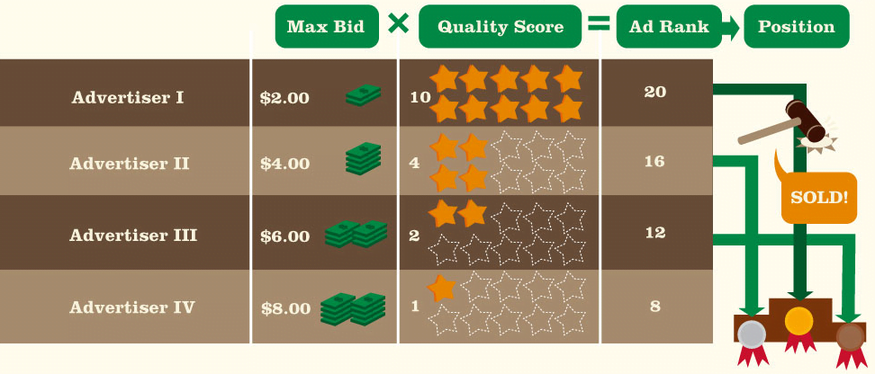
But Quality Score doesn’t just affect your ad position – it also has an enormous effect on how much you pay when someone clicks your ad.
How Quality Score Affects Cost Per Click
Your cost per click (CPC) is determined by the following formula: the ad rank of the advertiser below you, divided by your Quality Score, plus 1 cent. The chart below illustrates how this formula makes it possible to rank higher than advertisers who are actually paying more.
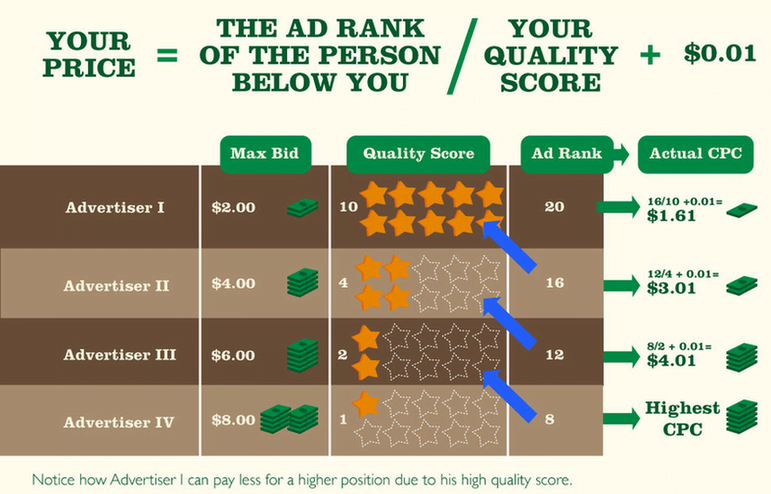
This is all well-known. What’s not so well-known is that Quality Score is even more valuable today than it used to be. I’ll explain how in the next section.
The Changing Relationship Between CPC & Quality Score
In 2009, Craig Danuloff at Click Equations published some charts that showed how much money you save in Google Ads by raising your Quality Score. They looked like this:

At the high end, a QS of 10 provided a 30% discount on CPC compared to someone whose Quality Score was 7. At the low end, having a Quality Score of 1 forced you to pay 600% more. (Suckers.)
Back in March, I decided to revisit these numbers. Craig originally used 7 as the neutral value because it was the mean Quality Score across most accounts at the time. The thing is, average Quality Scores have fallen over time. In 2013, impression-weighted average Quality Score in 2013 is closer to 5.
If you’re thinking, “So what?,” let me make it clear: That drop in the average Quality Score means that having a QS of 10 now saves you 50% over the average advertiser – 66% more than it saved you four years ago. Even a meh QS of 6 saves you about 17% – in 2009, a 6 would have cost you. Here’s what the savings look like given the new landscape:
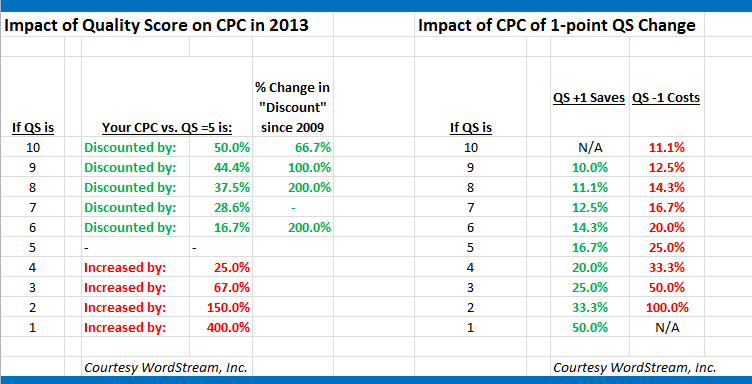
Of course, some people will still tell you that Quality Score is overrated, because CPC savings are meaningless compared to cost per conversion.
Why Optimizing for Quality Score and Optimizing for CPA Are the Same Thing
What those Quality Score detractors don’t seem to realize is that QS is every bit as important in determining your cost per conversion, as well. Here’s how I know:
To quantify the relationship between cost per conversion and Quality Score, I manually compiled CPA data from thousands of campaigns across several hundred WordStream client accounts, representing about $100 million in annualized spend.
I then plotted the average cost-per-conversion versus the impression-weighted Quality Score for each campaign. Here’s what it looked like:
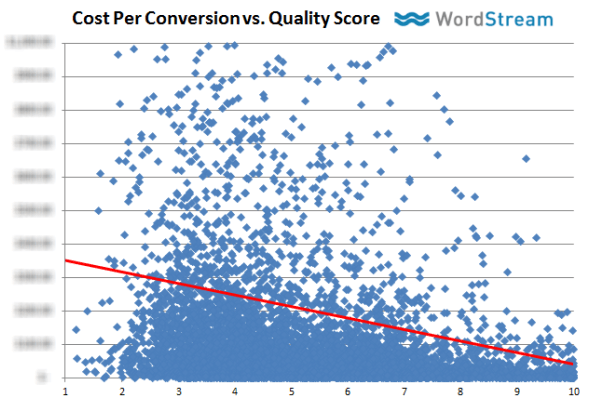
The data reveals that there is a very strong relationship between average cost per conversion and average Quality Score. Just as above, the higher your Quality Score is, the lower your CPA will be on average. So optimizing for Quality Score and optimizing for CPA are essentially the same thing.
The below table show how much you’ll save on CPA (not CPC) if your Quality Score is higher than 5:
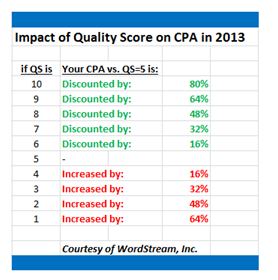
Note that if your QS is below the average, you’ll essentially pay a penalty – up to 64% more per action than your average competitor. In a nutshell, for every Quality Score point above the average 5/10 score, your CPA will drop by 16% on average. Conversely, for every Quality Score point below the average of 5/10, your CPA will rise by 16%.
Michael Wiegand at Portent found similar results a few months back – that for each point that your QS goes up, there was an average CPA reduction of 22%. The main difference between his study and mine is that my data size is about 100x bigger.
It’s worth pointing out that I didn’t see a big difference in average conversion rates vs. Quality Scores. I found that keywords with high Quality Scores converted only slightly better than low Quality Score keywords, meaning that lower CPAs are primarily driven by lower costs per click — which are a direct result of your Quality Score.
(Note: I wrote about my findings over at Search Engine Land last week – there’s some interesting discussion in the comments over there, so check it out if you want to dig into the data in more detail.)
4 Ways to Improve Your Quality Score
At the risk of repeating myself, I think these numbers show that optimizing for Quality Score and optimizing for cost are essentially the same thing. High Quality Scores give you lower costs per click, and lower CPCs almost always translate into lower costs per conversion.
So how do you get your Quality Scores up above the average? Here are four quick tips:
- Use ad extensions. Google ad extensions and Google sitelinks make your ads bigger with more places to click, so they increase CTR (at no extra cost).
- Write better ad text. We co-wrote a guide with PPC Hero that has ten tricks for increasing CTR, including no-brainer stuff like using symbols and exclamation points.
- Bid on brand terms. Branded keywords tend to have really high click-through and conversion rates and they can bring up your whole account average.
- Be more methodical about account organization. Don’t just add new keywords to the same ad group until it’s 200 large. Make sure each ad group is organized around a clear theme. If an ad group has 50+ keywords, try to break it down into smaller, tighter groups.
So what do you think about these results? Let me know in the comments. Got problems with my data? Bring it on.







